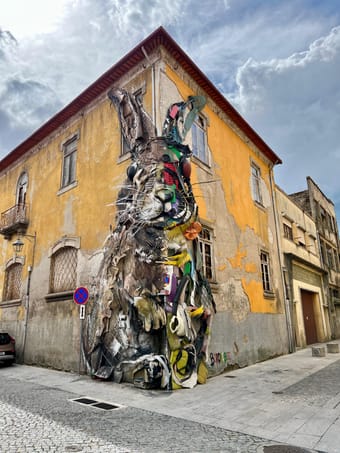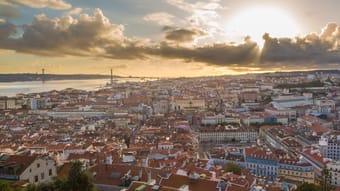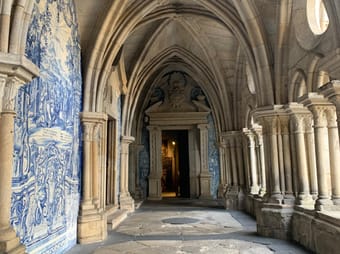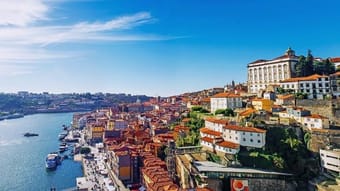Results for Portugal Art
One man's trash is another man's treasure 💙 Artur Bordalo, also known as Bordalo II (pronounced Bordalo Segundo), was born in 1987 in Lisbon, Portugal. He is famous for using street garbage and discarded materials to create stunning animal sculptures. His underlying message is about excessive consumerism and waste, pollution and all types of endangered species. His works, which can be found all over the world, are referred to as "trash art."
This free guide includes:
🔹52 art installations of Bordalo II in & around Portugal, broken down by region
🔹Interactive map with tagged locations (use the map icon below to toggle between the guide and full map)
🔹All but a few are found outdoors (some are in restaurants as noted), and free of charge to view!
This is not an exhaustive list by any means, and not all of his pieces are permanent exhibits. But hopefully it will help you keep your eyes open for Bordalo's work while traveling around Portugal. His art pieces are really unique and I hope you enjoy spotting them in the wild as much as I do!
If this guide was helpful and you'd be interested to see more like this in the future, please let me know in the comments below! Thanks for supporting my work! 🫶🏻💙
Car-free • Couples • Backpacker • Digital Nomads • Family • Groups • Female Solo • 50+ • Adventure • Architecture • Art • Design • Photography • People & Culture • History • Road Trip • Slow Travel • Wine
$14.99
45
Lisbon is a total gem of a city where traditional heritage meets modern vibrancy, and this is nowhere more evident than in its food and culture scene. The city is a bustling metropolis that offers a unique blend of the old-world charm with contemporary flair, making it a must-visit destination for culture enthusiasts and foodies alike.
Lisbon's culinary scene is a reflection of Portugal's rich maritime history, with an emphasis on fresh seafood. Cod (bacalhau) dishes are ubiquitous, served in various forms such as "Bacalhau à Brás" (shredded cod with onions, potatoes, and eggs). Sardines, especially grilled sardines (sardinhas assadas), are another staple during the summer months. But Lisbon's food scene isn't limited to seafood; "Alheira," a type of sausage made from meats other than pork, and "Bifana," a traditional pork sandwich, are also popular among locals and tourists.
Pastries and sweets hold a special place in Lisbon's culinary landscape, with "Pastéis de Nata" (custard tarts) leading the charge. These creamy, flaky pastries originated in the city's Belém district and are a must-try for anyone visiting Lisbon. The city's coffee culture is equally noteworthy, with cafes and pastelarias dotting every corner, inviting visitors to indulge in a leisurely "bica" (espresso) paired with a pastry.
Lisbon's culture is as diverse as its culinary offerings. The city is renowned for Fado music, a soul-stirring genre characterized by its melancholic tunes and lyrics that reflect the Portuguese concept of "saudade," or longing. Visitors can experience live Fado performances in various "casas de Fado" throughout neighborhoods like Alfama and Mouraria, offering an intimate glimpse into Portugal's soul.
Art and history are woven into the fabric of the city, with numerous museums and galleries showcasing everything from contemporary art to artifacts that trace Portugal's maritime exploits. The LX Factory, a former industrial complex turned cultural hub, epitomizes Lisbon's blend of historical roots with modern creativity, hosting art studios, bookshops, eclectic boutiques, and thematic restaurants.
The city's architecture is another highlight, with the Pombaline downtown area (Baixa) offering a grid-like layout unique to Europe, majestic plazas like Praça do Comércio, and iconic monuments such as the Belém Tower and Jerónimos Monastery. The juxtaposition of traditional azulejos (ceramic tiles) adorning buildings with street art and murals in districts like Bairro Alto and Graça adds to the city's vibrant aesthetic.
Lisbon is a city that delights the senses and stirs the soul, offering a rich tapestry of food and culture that seamlessly blends tradition with innovation. Whether it's in the simple pleasure of a Pastel de Nata, the haunting melodies of Fado, or the intricate beauty of azulejos, Lisbon invites exploration and promises unforgettable experiences.
50+ • Business • Car-free • Female Solo • Digital Nomads • Family • Architecture • Art • Boutique • Design • Foodie • History • Luxury • People & Culture • Photography • Romantic • Relaxation • Wine • Shopping • Coffee
$5.00
0
1. Jeronimos Monastery
Cost: €12 for adults, free for children under 12, €6 for seniors (65+), and €6 for students; or free with the Lisboa Card.
Highlights:
Jeronimos Monastery, also known as Mosteiro dos Jerónimos, is a stunning example of Manueline architecture, a Portuguese style that combines Gothic and Renaissance elements with maritime motifs. Commissioned by King Manuel I in the early 16th century, the monastery was built to commemorate Vasco da Gama's successful voyage to India and to give thanks to the Virgin Mary for his safe return.
The monastery's architecture is simply spectacular. The intricate stone carvings adorning the façade showcase the wealth and artistry of Portugal's Age of Discovery. Detailed motifs, such as twisted ropes, sea creatures, and botanical elements, reflect the country's seafaring history and the natural world. And inside, visitors can marvel at the beautiful cloisters, considered some of the most magnificent in the world.
Tips:
- With so much to see, make sure to plan to spend at least a couple of hours exploring the monastery and its grounds.
- After your visit, take some time to check out from Pastéis de Belém, which has been serving their famous custard tarts since 1837. It's just a short walk from the monastery and is a must-try treat while in Lisbon.
Best Time to Go: The lines can get very long, so make sure to get there right when they open at 9:30 am.
2. Miradouro de Santa Luzia
Cost: Free
Highlights: This miradouro (viewpoint) offers one of the best views in Lisbon, as it provides a panoramic look at the Alfama district and the Tagus River. The tiled mosaics and beautiful gardens add to its charm, making it the perfect spot to catch a sunset.
Best Time to Go: We recommend going at sunset. The views at sunset are especially breathtaking at that time and the lighting is perfect for photos.
3. Carmo Convent
Cost: €7 for adults, €5 for children, students, & seniors.
Highlights: The Carmo Convent, a stunning example of Gothic architecture, stands as a significant reminder of Lisbon's past. Partially destroyed by the devastating earthquake of 1755, the convent's roofless nave creates a beautiful open-air space. Today, it houses the Carmo Archaeological Museum, where visitors can explore a fascinating collection of artifacts, including prehistoric relics, medieval tombs, and ancient sculptures.
Best Time to Go: The Carmo Convent tends to get crowded in the afternoon, so we recommend getting there when it opens at 10 am.
4. Praça do Comércio
Cost: Free
Highlights: One of the largest squares in Europe, Praça do Comércio is bordered by impressive yellow buildings and the Tagus River. It's a vibrant hub of activity with restaurants, cafes, and the iconic Rua Augusta Arch.
Best Times to Go: We recommend going in the early evening to catch the sunset. The square is also beautifully lit at night, perfect for a leisurely stroll after dinner.
5. Lisbon Cathedral
Cost: €5 for adults, €3 for children
Highlights: The oldest church in Lisbon, the Lisbon Cathedral features a mix of Romanesque, Gothic, and Baroque architectural styles. Highlights include the impressive rose window, the Gothic cloister, and the treasury with its collection of sacred art.
Best Time to Go: To avoid the crowds, we recommend going in the early morning or late afternoon.
Backpacker • Digital Nomads • Female Solo • Couples • Architecture • Photography • Slow Travel • Budget
Free
0
Complete guide with attractions and venues where to eat/drink, get those very special souvenirs from (bespoke & local brands and markets) and catch a beautiful sight…or just your breath after walking up and down the hills of this marvellous city. Lisbon is all about art, colors, architecture and GOOD vibes! 🇵🇹💚
💡General tip: combine Lisbon with visits/stays in Sintra and Porto.
Highlights:
🚋 Trams - The Lisbon tramway network is a system of trams in operation since 1873; it presently comprises six lines and has a length of 31 km with 63 trams in operation (45 historic "Remodelados", 8 historic "Ligeiros" and 10 modern articulated trams). Tram 28 is famous because happens to go past many of the city's most significant landmarks in districts like Alfama, Baixa and Estrela. Because the route also uses some heritage-style tram carriages, it has become a popular tourist attraction in the city.
💠 Azulejos - is a form of Spanish and Portuguese painted tin-glazed ceramic tilework. Azulejos happen to be one of the most distinctive art forms in Portugal and are found on the interior and exterior of churches, palaces, ordinary houses, schools, and nowadays, restaurants, bars and even railways or subway stations.
🧼 Soaps - Oprah Winfrey said they're one of her favorite things, so the world is now also a fan of Portuguese soaps. But they're not recent products. They've been made since the 1800s and are 100% natural. They've maintained beautiful Art Deco and Art Nouveau packagings from the 1920s, and have become one of the favorite gifts to take from Portugal.
🥮 Pastel de nata - is a Portuguese egg custard tart pastry, optionally dusted with cinnamon - looks like a cross between a custard tart and a cake; created by monks in the Jerónimos Monastery, a major tourist attraction today and a UNESCO World Heritage Site.
🍲You also have to try these traditional dishes: Bifana, Sardines, Caracoletas & Prego na Pao, Alheira de Mirandela, Queijadas.
🧉Ginja - also known as ginjinha. This sour cherry liqueur is a tourist favorite but has sweetened locals’ palates for a long time too. There are establishments in Lisbon entirely dedicated to selling this sweet beverage made with Morello cherries, a variety of spices, and plenty of sugar. Nowadays, ginja is also served in edible chocolate cups. While you may choose among white chocolate, milk chocolate and dark chocolate, dark chocolate does indeed pair beautifully with the super sweet, almost syrupy drink.
Shopping
$5.00
18
Discover Lisbon through art with this guide. Unfold the charm of local galleries, street art, and cultural spots as you navigate the city's vibrant artistic landscape. Make your creative weekend memorable!
Backpacker • Couples • Family • Digital Nomads • Female Solo • Art • Architecture • Foodie • Design • People & Culture • Photography • Slow Travel
$15.00
0
Dawn Hagin
Available for hire
A Very Opinionated, Bossy, No-Nonsense, Portugal Road Trip Itinerary (Lisbon & North)
It seems that everyone has an opinion on Portugal, amirite? You've seen dozens of Lisbon and Porto "must do" Instagram reels for this uber-popular (and rightly so!) country. So, what's this free guide gonna offer you? My own bossy opinions on what to do, where to eat, what not to miss, and where to stay. That's it. Covers top recommendations for 4-5 days in Lisbon and about 10 days on a road trip north to Cascais, Sintra, Aveiro, Porto, and The Duoro Wine Region. I've spent 10 weeks in Portugal on three separate trips and these are my tips.
50+ • Couples • Digital Nomads • Architecture • Art • Boutique • Foodie • People & Culture • Photography • Romantic • Slow Travel • Wine
Free
6
Porto is a vibrant little city, small enough to walk every corner but big enough to boast centuries of history and architecture. Known as the hometown of Port, it’s also a destination for azulejos (the classic hand painted tiles), street art, and excellent food.
This guide is best for first time visitors who want to spend their time exploring the city for a few days!
On this guide, you’ll get:
- the major sights with notes on what you’re seeing and if they need advanced booking
- an interactive map to help navigate you to each spot
- recommendations on typical dishes to order
- 13 things to see and whether you should pay to enter or not
- 8 places to eat at varying price points, 5 port wineries, 5 bars, 5 cafes/breakfast spots
Foodie • Adventure • Architecture • Art • History • People & Culture • Wine • Slow Travel • Romantic
$25.00
3
Lisbon whispers promises of adventure around every winding corner. This vibrant city, perched on Portugal's sun-drenched coast, is a captivating blend of history, charm, and cultural energy.
Imagine yourself strolling through the Alfama, Lisbon's ancient heart, where cobbled lanes echo with the soulful sounds of Fado. Then, take a ride on a vintage tram, clinging to a hillside as the city unfolds beneath you. Lisbon beckons with its delicious Pastel de Nata pastries, its iconic Jerónimos Monastery, and breathtaking sunsets over the Tagus River.
Get ready to lose yourself in Lisbon's magic, a city that will leave you yearning to return.
50+ • Accessibility • Backpacker • Business • Couples • Digital Nomads • Family • Groups • LGBTQ+ • Plus Size • Female Solo • Architecture • Art • Boutique • Budget • Design • Foodie • History • Luxury • People & Culture • Photography • Romantic • Shopping
$5.00
3
Picture: castles and hills by the seaside. What's not to love! It’s an simple day trip from a Lisbon. You can do it as a relaxed day of nature and castles or a packed day of sightseeing all the majors!
This guide gives you:
- the best options on how to get there
- what to prioritize if you want a slower day or a do-it-all day
- 2 lunch options at different price points
- how to get between each place (they're not walkable, and parking isn't simple)
- pro tips on what to look for within each palace or site
- an interactive map to help navigate you to each spot
Art • Architecture • History • People & Culture • Foodie • Romantic
$8.00
3
Travelers often ask, “Should I take a day trip from Porto and visit Aveiro”? And the answer is “YES!” It is like no other city in Portugal and on my list of top underrated cities on the peninsula. Aveiro is a city known for its canals, colorful boats, and Art Nouveau architecture. It is often referred to as the "Venice of Portugal" due to its network of canals and longboats or moliceiros. The city also has a strong tradition in ceramics, salt harvesting and tasty pastries as well as being located on the Atlantic coast, making it a popular destination for beachgoers. The beaches have a blue flag rating as well, which means the waters are rated as outstanding and pure. You might even like it enough to spend the night and give it another day of your trip.
50+ • Backpacker • Business • Car-free • Couples • Digital Nomads • Family • Groups • Halal • LGBTQ+ • Pets • Plus Size • Female Solo • Vegetarian • Architecture • Art • Budget • Design • Foodie • History • Outdoors • People & Culture • Photography • Romantic • Shopping • Slow Travel
Free
0
Discover the magic of Lisbon, Portugal, a city where old-world charm meets modern vibrancy! From the iconic trams winding through historic neighborhoods to hidden gems waiting to be explored, this guide will unlock the best of both worlds. Whether you're craving mouthwatering local bites at secret spots or looking for the perfect Instagram-worthy views, we've got you covered. Ready to experience Lisbon beyond the typical tourist traps? Grab our guide and embark on an unforgettable adventure! 🌟✈️ #ExploreLisbon #HiddenGems #TravelGuide
Couples • Digital Nomads • Family • Groups • Female Solo • LGBTQ+ • 50+ • Architecture • Art • Foodie • People & Culture • Photography • Romantic • Wine
$15.00
0
Welcome to Lisbon, a city where traditional charm meets vibrant modernity. Whether you’re a foodie, history buff, or urban explorer, Lisbon offers an unforgettable experience in just one day. From historic neighbourhoods to contemporary art, and from delicious pastries to gourmet meals, this guide will help you navigate the best of Lisbon in 24 hours.
Backpacker • Car-free • Couples • Digital Nomads • Groups • LGBTQ+ • Female Solo • Vegan • Vegetarian • Architecture • Art • Budget • Foodie • History • Outdoors • People & Culture • Photography • Romantic
Free
0
These things are my essentials for the city of bridges but I figured I'd give them to you for free cause we're friends. 😉
Porto has my heart. Always and Forever (Iykyk)
I'm a creature of habit who believes in short stays vs vacations. 1-3 months vs 1-3 week and so these are the essentials for me (though these will work for everyone). Wherever I go these are the things I'm doing, the places I need to know immediately and the spots I'll return to time and time again.
Foodie • Shopping • History • People & Culture • Slow Travel • Coffee • Relaxation • Nature • Budget • Art • Architecture
Free
0
Welcome to my completely unorganized but oh-so-helpful map of Portugal! An absolute smorgasbord of my own travels and research, suggestions from friends and strangers, and many treasures found along the way, this is where I compile all things Portugal for my future trips and yours. Things I particularly love that you’ll find a lot of:
☕️ Coffee shops & bakeries
🌮 Local cuisine
🏛️ Museums of all kinds
🌳 Gardens & parks
🛏️ Boutique hotels
🍕 Small regional chains with good reputations
All my guides in this category are $5 per 100 places included, but since I add to these constantly, you can lock down the lowest price today and gain a lifetime access!
Couples • Family • Architecture • Art • Budget • History • Foodie • Design • Coffee • People & Culture
Free
0
Lisbon has it all: gorgeous buildings, local music, incredible food, fascinating history, and more! This itinerary is ideal for a first-time visitor that wants a deep dive into Lisbon in a short amount of time.
I also offer an add-on board for exploring Sintra if you have another day! It’s an easy day trip from Lisbon.
On this guide, you’ll get:
- the major sights with notes on what you’re seeing and if they need advanced booking
- an interactive map to help navigate you to each spot
- instructions on how to get around Lisbon
- a few activities for each day, with guidance on which are more optional and which are must-do
- 6 restaurants at varying price points, 2 bars, and 2 tours worth the cost!
Foodie • Art • Architecture • History • People & Culture • Slow Travel • Wine • Coffee
$15.00
6
Oporto stuns with its soul. Terracotta rooftops cascading down colorful hills, each house a unique hue. Wander cobbled streets bathed in golden sunlight, This is definitely Portugals gem, a must-visit on Europe's Atlantic coast.
Architecture • Art • Boutique • Coffee • Design • Foodie • History • Luxury • Outdoors • People & Culture • Photography • Shopping • Slow Travel • Wellness • Wine • Romantic
Free
0
Portugal is a captivating destination renowned for its unique blend of history, culture, and natural beauty. Visitors can explore medieval castles, ancient Roman ruins, and ornate palaces in historic cities like Lisbon and Porto, as well as the fairytale-like landscapes of Sintra.
Along the Atlantic coastline, stunning beaches, dramatic cliffs, and picturesque fishing villages await exploration, while inland regions offer opportunities for wine tasting in the Douro Valley and outdoor adventures in nature reserves like Parque Nacional da Peneda-Gerês. With its vibrant culture, delicious cuisine, and warm hospitality, Portugal offers travelers unforgettable experiences in every corner of the country.
Couples • Business • Groups • Art • Architecture • Design • Foodie
$20.00
0
Coimbra makes a perfect day trip from Lisbon or Porto if you're based in either charming city on your trip to Portugal. Better yet, spring to spend a night or two in this magical city! History, romance, and all around charm will delight you on your visit to Portugal's old capital!
Below are some of my recommendations for your trip to Coimbra!
Family • Groups • Female Solo • Car-free • Couples • Backpacker • Architecture • Art • Boutique • Budget • Faith • History • Luxury • People & Culture • Photography • Romantic
Free
2
Lisbon's a total vibe. Sun-drenched city with chill cafes by the water. Pastel buildings line charming streets, begging for pics. Ride the iconic yellow trams, a vintage ride through history. Foodies? Fresh seafood and delicious pastries are everywhere.
Family • Couples • Groups • LGBTQ+ • Female Solo • Architecture • Adventure • Art • Boutique • Coffee • Design • Foodie • Faith • History • Luxury • Outdoors • People & Culture • Photography • Relaxation • Road Trip • Romantic • Shopping • Wellness
Free
0
Ask ThatchGPT


















